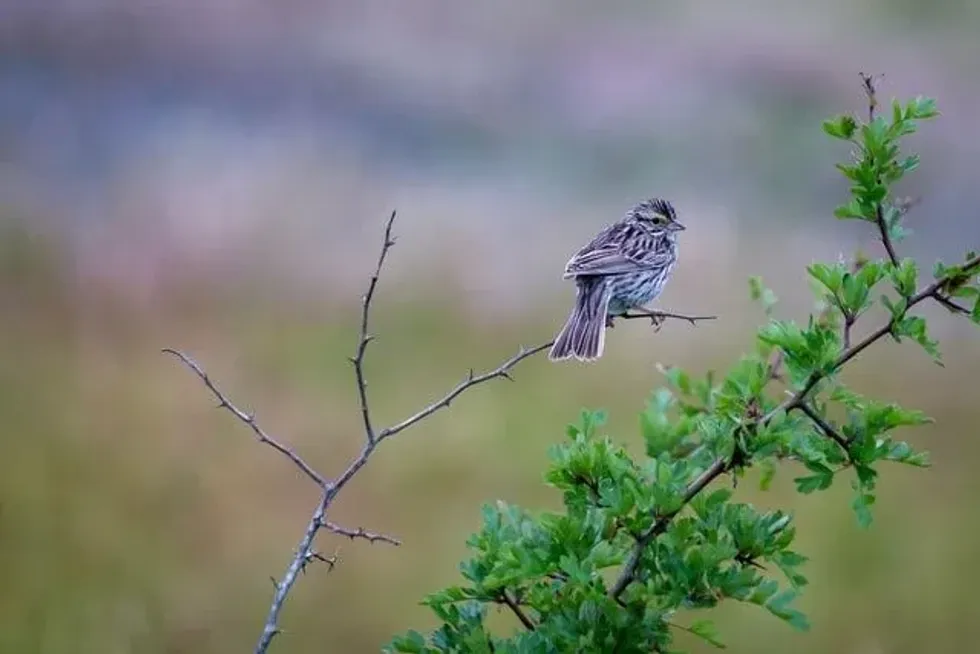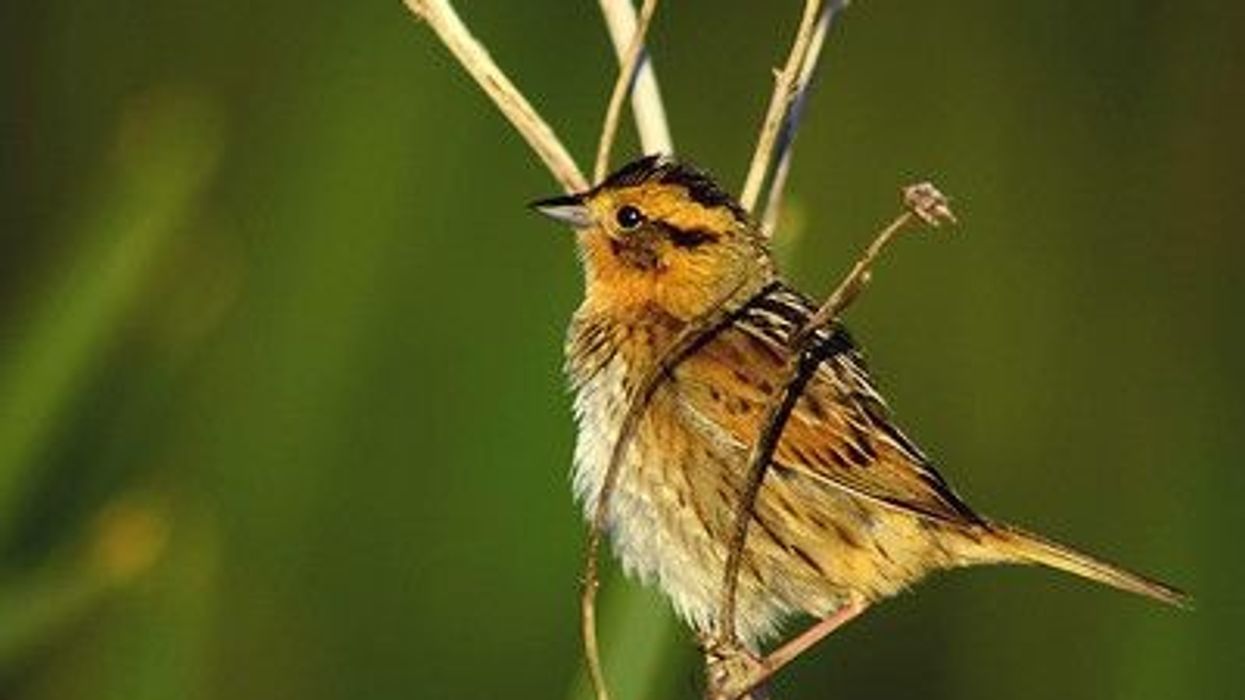The Savannah sparrow, (Passerculus sandwichensis) belongs to the order Passeriformes, family Passerellidae, and genus Passerculus. As most subspecies of the sparrows seem similar, distinguishing them can be difficult.
This is mainly because they all have a special talent for chirping happy songs! To identify a Savannah sparrow from a variety of different sparrows, you try and observe their field markings. Every sparrow has its own different field marking.
Savannah sparrows are found in North America, Mexico, Alaska, Guatemala, and many other locations. They love to prey on insects and feed on seeds and berries in winter.
Their flocks are known to migrate during the winter season. Discover lots of Savannah sparrows facts here, and for more interesting facts check out our guides to the tawny frogmouth and the kagu too.
Savannah Sparrow Interesting Facts
What type of animal is a Savannah sparrow?
The Savannah sparrow is a species of birds belonging to the Passerellidae family of animals.
What class of animal does a Savannah sparrow belong to?
The Savannah sparrow is a New World sparrow that is part of the Aves class.
How many Savannah sparrows are there in the world?
This is a not extinct breed of sparrows as Savannah sparrows have a current population of 170,000,000 breeding birds across parts of North America and some other areas.
Where does a Savannah sparrow live?
These birds are found mainly in grassy areas of North America and in Central America. Some places where these species live are Canada, the southern United States, Mexico, Costa Rica, Panama, and Bahamas. They are also found in Russia, Japan, and the United Kingdom.
What is a Savannah sparrow's habitat?
This bird's habitat focuses on wetlands, salt marshes, grasslands, beaches, tundra, shrubs, and estuaries. Savannah sparrows forage on the ground and can often be found in low bushes. These birds perform winter migration and during the winter seasons are usually found in the grazed grassy areas on low-growth lands.
Who do Savannah sparrows live with?
Savannah sparrows are birds that belong to a social group. They live together in a family with their own subspecies. For the Savannah sparrow, winter migration is an important social movement and they are known to gather in their large flock to travel to warmer climates.
How long does a Savannah sparrow live?
The Savannah sparrow (Passerculus sandwichensis) has a short lifespan of just six years in the wild.
How do they reproduce?
avannah sparrow birds are a mix of polygamous and monogamous species. Some birds mate just once, and if their partner visits again, they might pair with them too in the next season.
The adult male is known to sing a distinctive Savannah sparrow song to mark its territory and to attract adult female birds. The adult female bird builds the nest with dry grass and other dried sticks in an open cup shape over the span of three days.
The nest is usually built in between bushes or in highly vegetated spaces.
It is also sometimes built near the ground during the breeding season. The adult female then lays her clutch of around two to six eggs.
The eggs are incubated for 10 to 13 days and then the adult male and the adult female both take care of the baby birds and feed them until they fledge. The young birds are usually dependent on their adult parents for three weeks.
What is their conservation status?
The Savannah sparrow (Passerculus sandwichensis) is considered to be of Least Concern. Although, one of the subspecies of this bird, Belding's Savannah Sparrow is marked as Endangered. Also, there are 17 subspecies of Savannah sparrows listed by the International Union for Conservation of Nature.
Savannah Sparrow Fun Facts
What do Savannah sparrows look like?
Savannah sparrows are small-sized North American birds with short-notched tails and a fluffy-plump body. They have a small head with dark eyes and a bill that is usually small with a thick base.
Their feet and legs are a horn color and their head is whitish with a small yellow patch on the face, usually near the bill. Their upper body is brown or dark gray and their underparts and chest are white. Both these parts have thin brown or black streaks.
Similarly, their cheeks are brown and the underparts of the throat and body are white with thin streaks on the chest. They have blackish-brown flight feathers with a border lining of either pale brown or white color.
How cute are they?
They are short and make a sweet and thin, high-pitched sound. They have pretty detailed feathers, and take quick short flights which makes them cuter for an onlooker!
How do they communicate?
This species of bird communicates using small chirps and tweets. The variation in these sounds and the different levels of intensity that they make these sounds at is how they communicate with each other. They do not interact much with the other species of birds, only those from their own family and class.
How big is a Savannah sparrow?
Savannah sparrows belong are small North American birds. With a size of 4.3-6.7 in (11-17 cm), they have the capacity to become double the size of bee hummingbirds who are considered to be the smallest birds. They can look as big as 7.1-9.8 in (18-25 cm) due to their wingspan too.
How fast can a Savannah sparrow fly?
These sparrows take quick flights. This bird flies swiftly and can fly at a speed of around 50 mph (80.4 kmph).
How much does a Savannah sparrow weigh?
Like many other small North American birds, a Savannah sparrow's weight ranges anywhere between 0.03-0.06 lb (15-29 g).
What are their male and female names of the species?
There are no specific names based on the gender of this subspecies of birds.
What would you call a baby Savannah sparrow?
Just like other young sparrows, a young Savannah sparrow bird is called a chick.
What do they eat?
Savannah sparrows are omnivores. They can also be described as insectivores as they consume a huge amount of insects, especially during their breeding season.
Their diet includes insects, spiders, and insect-like invertebrates. Those found near the coast might also find mollusks, small crustaceans, and other species that are easily available around coastal areas to feed their young whilst they grow. During winter, they are known to feed on berries, grasses, and seeds that might have been spilled in fields or open spaces.
Are they dangerous?
There haven't been any known cases of danger to humans being caused by this bird. Although, when it comes to saving its baby and protecting its nest, this species can become aggressive in order to defend its family.
Would they make a good pet?
These sparrows are wild birds who live around the coast or in open fields, so this wild bird is not advised to be kept in captivity or as a pet.
Did You Know...
The Savannah sparrow and song sparrow are separate species and are often confused by onlookers. Savannahs have a short notched tail, a short and light bill with yellow stripes around it, and crisp streaks on their chest, whereas song sparrows have a long tail, a dark bill, and bold streaks that usually form spots on their chests.
Another savannah sparrow vs song sparrow difference is, it is it worth noting that Savannahs have a buzzy insect-like chirp while song sparrows produce clear and whistled notes.
Sparrows eat insects and this is a real specialty of the bird. By eating these insects they help to keep insect populations in check.
Why is the Savannah sparrow endangered?
Belding's Savannah sparrow species is considered to be endangered. This is mainly because of two reasons, one being the depletion of salt marshes due to commercial and residential developments.
The second reason can be attributed to the increasing numbers of visitors and hikers in their habitats. These visitors can accidentally damage the Belding's Savannah sparrow sparrows' ground nests that are made with dry grass by the bird. The damage to this species' habitat and nesting ground has had a large negative impact.
What does a Savannah sparrow sound like?
The sound of these birds is quite buzzy and might sound a bit like an insect. Their songs have three phrases, which can be distinguished especially when an adult male Savannah sparrow sings to attract a mate during the breeding season.
This Savannah sparrow call starts with short notes, with a single high one after, which is then followed by their distinctive insect-like trill. Apart from adult males, adult females, as well as juvenile Savannah sparrow birds, have a flight call too.
Here at Kidadl, we have carefully created lots of interesting family-friendly animal facts for everyone to discover! Learn more about some other birds including the Adélie penguin, or the jacana.
You can even occupy yourself at home by drawing one on our sparrow coloring pages.










